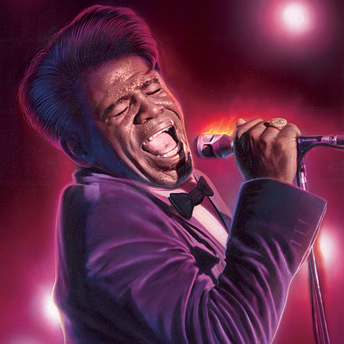"A colored is a frightened-to-death Afro American. A Negro
is one that makes it in the system, and he wants to be white. A nigger, he's
loud and boisterous, wants to be seen. Nobody likes a nigger. A black man
has pride. He wants to build, he wants to make his race mean something.
Wants to have a culture and art forms. And he's not prejudiced. I am a black
American man. Now you go ahead and print it."----James Brown, 1982

James Brown (1933-2006), also known as the "hardest working man in show
business" and sometimes called the "godfather of soul," was born in
Barnwell, South Carolina. His father worked in the woods harvesting
turpentine and moved his family to Augusta, Georgia when James was very
young. There, Brown lived at a brothel in the black section of town and
earned money shining shoes. He quit school after the 7th grade and
served a 3 year sentence at a reformatory (for petty theft) in his youth. He
was involved with music from a very early age. He was befriended by Cliff Brantly, the man who managed Little Richard, and offered an apartment above
one of his nightclubs in Macon, Georgia. He joined the house band there and
also did some work with pianist Bobby Byrd, who had a gospel group. This
group, the Three Swanees, eventually evolved into Brown's backup group, the
Famous Flames. They had their first hit in 1956, Please, Please, Please.
Brown's group developed a signature style that included a choke-rhythm
guitar, punchy horn riffs, a stuttering bass, and one chord drones that
supported his unique vocal style. Listen to Cold Sweat for a
great example of this sound.
Brown was an extremely high energy performer who danced up a storm on
stage. He had very high standards for his band members and he frequently
fined them for tardiness, making mistakes, or not looking sharp enough. One
of his most common stage routines included a mock breakdown followed by
someone draping a cape or coat over him. Seemingly overcome, he would begin
to leave the stage only to "recover" and start performing again with manic
energy. You can get a sense for his stage persona from seeing his cameo in
the movie Ski Party.
In addition to being one of the most prolific artists in rock history (he
released more than 100 singles), Brown was also an African American icon.
His business empire included a chain of soul food restaurants, several radio
stations, and his own music business. He tried to be a model for younger
blacks and encouraged them to stay in school through his song "Don't be a
Dropout." During the riots in 1968 following the assassination of Dr. Martin
Luther King Brown was a voice for moderation pleading for people to "learn,
not burn." Perhaps his single most influential song was 1968's "Say it Loud,
I'm Black and I'm Proud."
